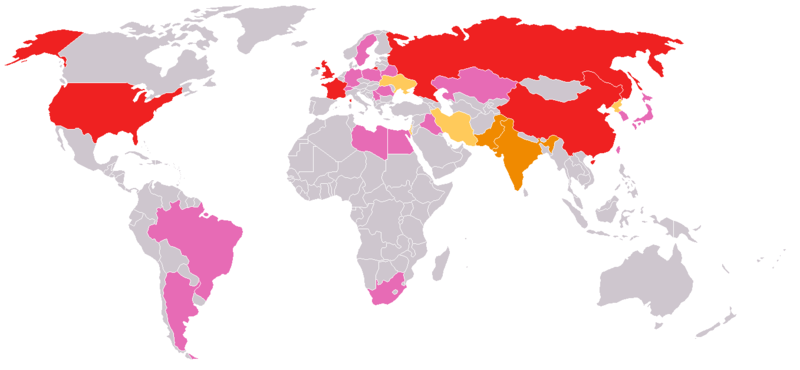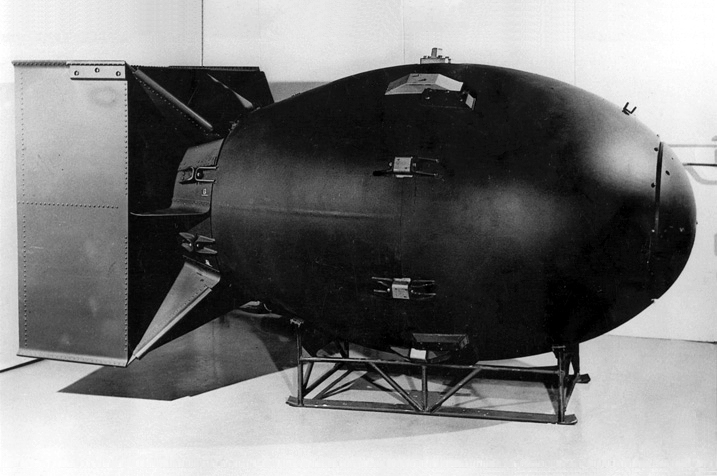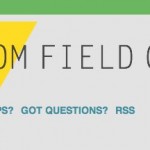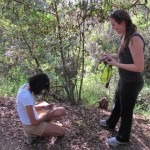As my internship at the Monterey Herald came to a close today, I can’t help feel a little a bad for all of the amputeed pages and pages of research in my longer stories that were on the wrong side of the cut.
The latest information to suffer this fate is from a story about Tamara Patton, a graduate student at the Monterey Institute for International Studies, who’s 3d modeling nuclear processing facilities using self-devised methods.

Nuclear Programs Worldwide As of 2005 (Red means a "Nuclear Weapon State" by the Nuclear Non-proliferation Treaty, Orange are other nuclear powers, Yellow are countries suspected of having nuclear weapons or programs, Pink are countries known to at one time have a nuclear weapon or a program. Courtesy of Wikimedia Commons.)
Now, modeling nuclear sites in 3d is not new, she told me. But apparently it is usually used by organizations like the International Atomic Energy Agency to determine where to place surveillance cameras and to plan inspections ahead of time, so they can optimally use the limited time they do have while physically on-site. With a virtual avatar, they can walk around a virtual building, like second-life or a videogame.
What is unusual is that she’s done this all using publicly available tools and resources. Google SketchUp provides the interface to push and pull shapes around to make three dimensional objects. Google Earth provides satellite images that she uses as the templates for her models. Though the overhead view by Google Earth doesn’t provide as much detail as close-up, on-site photography, Patton analyzes the shadows from the limited photographs combines them with time of day and location to accurately determine height.
She’s used her techniques to provide evidence that a textile factory is really just a textile factory and to help determine the production capacity for a nuclear facility of Pakistan.
It’s part of a new wave of intelligence where citizens without access to special tools or restricted information can participate, said Assistant Secretary of State Rose Gottemoeller of the Bureau of Arms Control, Verification and Compliance, in a speech at Stanford on Oct. 27 titled “Arms Control in the Information Age.”
There she asked:
Can we incorporate open source information technologies and social networking into arms control verification and monitoring?
What does she mean by this? She thinks that large groups of people can work together to either generate new sources of information gathering of dangerous weapons or provide deeper analysis of existing information.
For information gathering, she cites the Defense Advanced Research Projects Agency Red Balloon challenge as an example, where the agency offered a $40,000 reward to the first team to find 10 identifiable red weather balloons moored throughout the country (Out of 4,300 teams, an MIT team won in under 9 hours).
Then she extrapolates it to arms control:
Now, how could something like this work in an arms control context? Let’s just imagine that a country, to establish its bona fides in a deep nuclear reduction environment, may wish to open itself to a verification challenge. It could seek to prove it was not stashing extra missiles in the woods, for example, or a fissile material production reactor in the desert.
Of course, it sounds like there are a lot of potential holes in the challenge– blocking access, intimidating participants, fabricating results, plus the entire idea of offering an incentive not to find something– but she invited the audience, future members of the intelligence community, to come up with solutions.
The other half of her proposal was to use open source solutions to analyze publicly available information. In addition to Patton’s work, Gottemoeller cited the work of Laila Shereen Sakr, who predicted the fall of Libyan towns and cities hours beforehand, by building software that analyzed tweets from twitter and finding trends in hashtags.
It’s a far different way to do intelligence.








Comments are closed.